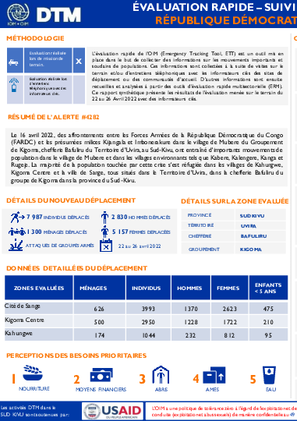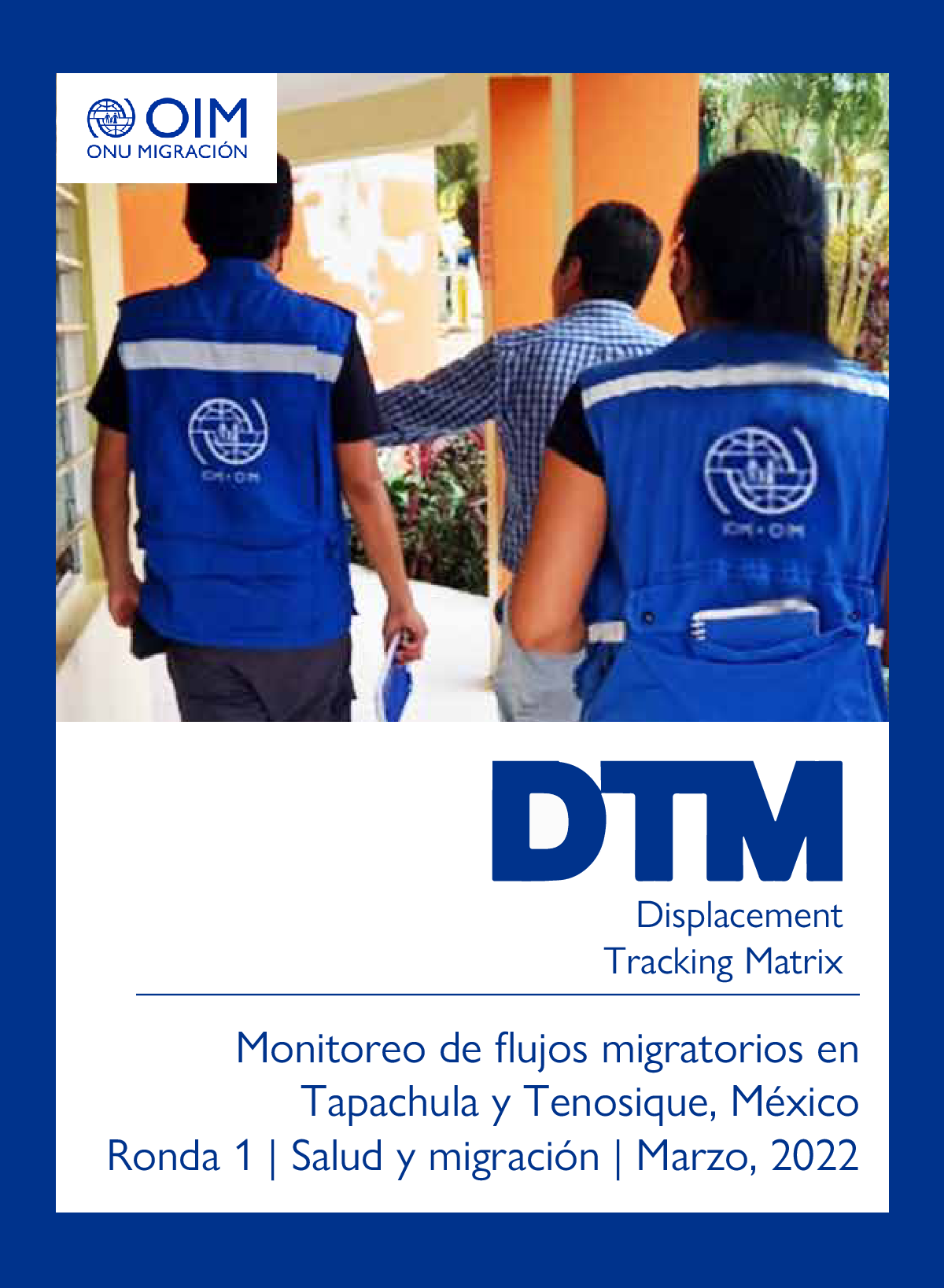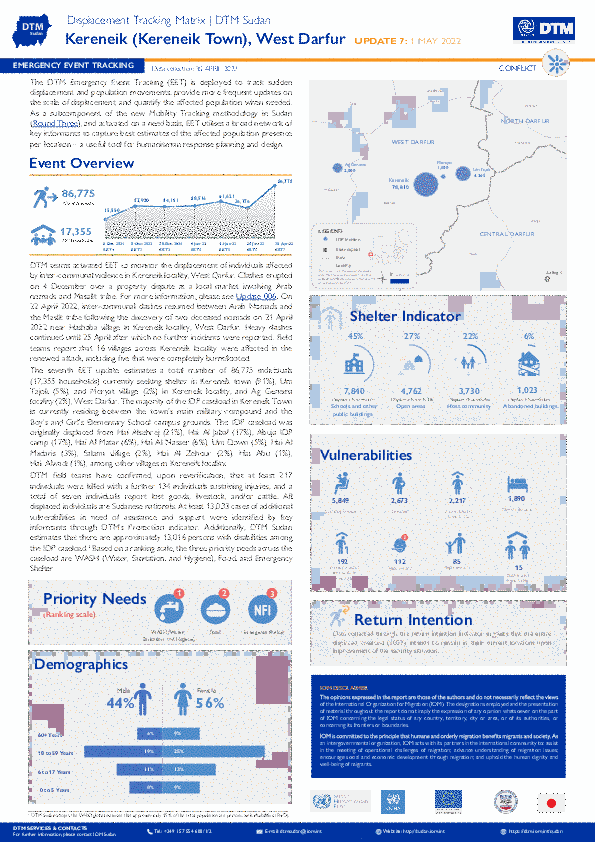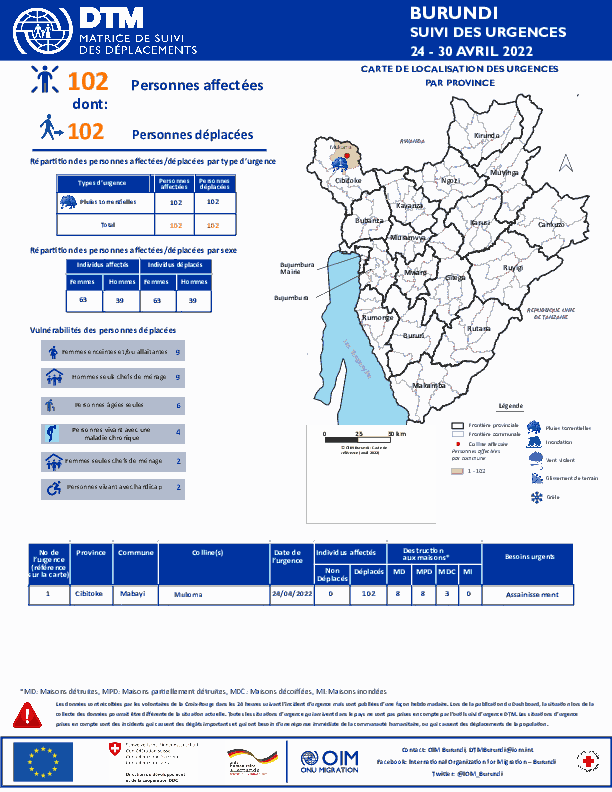-
Countries
-
Data and Analysis
-
Special Focus
-
Crisis Responses

Contact
DTM Support — iomdrcdtm@iom.int
Language
French
Location
Democratic Republic of the Congo
Period Covered
Apr 22 2022
Apr 26 2022
Activity
- Mobility Tracking
- Event Tracking
L’évaluation rapide de l’OIM (Emergency Tracking Tool, ETT) est un outil mis en place dans le but de collecter des informations sur les mouvements importants et soudains de populations. Ces informations sont collectées à la suite de visites sur le terrain et/ou d’entretiens téléphoniques avec les informateurs clés des sites de déplacement ou des communautés d’accueil. D’autres informations sont ensuite recueillies et analysées à partir des outils d’évaluation rapide multisectorielle (ERM). Ce rapport synthétique présente les résultats de l’évaluation menée sur le terrain du 22 au 26 Avril 2022 avec des informateurs clés.

Contact
Laura Canché, lcanche@iom.int
Language
Spanish
Location
Mexico
Period Covered
Jan 01 2022
Mar 31 2022
Activity
- Flow Monitoring Survey
- Mobility Tracking
- Event Tracking
Tapachula (Chiapas), y Tenosique (Tabasco), son las principales ciudades receptoras de personas migrantes en el sur de México. En el año 2021 se rompieron los récords de arribo de población migrante que ingresó a México por la frontera sur, según los registros de la Comisión Mexicana de Ayuda a Refugiados (COMAR), que reportó 89.636 solicitudes de reconocimiento de la condición de refugiado en Tapachula y 7.153 solicitudes en Tabasco. Sin embargo, el Instituto Nacional de Migración (INM) reportó solo 19.273 personas extranjeras documentadas como residentes permanentes por reconocimiento de refugio en todo el país. Paralelamente, el INM otorgó 87.174 Tarjetas de Visitante por Razones Humanitarias (TVRH) durante el 2021, de las cuales 20.364 se emitieron en Chiapas y 1.499 en Tabasco, principalmente por causa humanitaria, persona ofendida, víctima o
testigo de delito, y solicitante de la condición de refugiado.
El acceso a los servicios de salud presenta un comportamiento diferenciado entre ciudades debido a que las personas migrantes en Tapachula reciben atención principalmente en centros de salud del gobierno mientras que, en Tenosique, las ONG son el principal medio para acceder a servicios médicos. Por otro lado, los principales obstáculos que declararon enfrentar las personas que no pudieron acceder a servicios médicos en ambas ciudades son la falta de información y la falta de dinero.

Contact
DTM Sudan; dtmsudan@iom.int
Language
English
Location
Sudan
Period Covered
Apr 30 2022
May 01 2022
Activity
- Mobility Tracking
- Event Tracking
The DTM Emergency Event Tracking (EET) is deployed to track sudden displacement and population movements, provide more frequent updates on the scale of displacement, and quantify the affected population when needed. As a subcomponent of the new Mobility Tracking methodology in Sudan (Round Three), and activated on a need basis, EET utilises a broad network of key informants to capture best estimates of the affected population presence per location – a useful tool for humanitarian response planning and design.

Contact
DTM Nigeria, AllUsersInDTMNigeria@iom.int
Language
English
Location
Nigeria
Period Covered
Apr 23 2022
Apr 29 2022
Activity
- Mobility Tracking
- Baseline Assessment
- Points of Entry (PoE)
During the COVID-19 pandemic, IOM's Displacement Tracking Matrix (DTM), in collaboration with the World Health Organization (WHO), monitors cross-border movements to and from Nigeria's Borno State in north-east Nigeria. Assessments are conducted at Points of Entry located along the border with Cameroon.
A range of data was collected during the assessments to better inform on travellers’ nationalities, sex, reasons for moving, mode of transportation and timeline of movement as shown in figures 2 to 5 below.

Contact
DTM Nigeria, AllUsersInDTMNigeria@iom.int
Language
English
Location
Nigeria
Period Covered
Apr 25 2022
May 01 2022
Activity
- Mobility Tracking
- Event Tracking
Nigeria's north-central and north-west zones are afflicted with a multidimen-sional crisis rooted in long-standing tensions between ethnic and religious groups and involves attacks by criminal groups and banditry/hirabah (such as kidnapping and grand larceny along major highways). During the past years, the crisis has accelerated because of the intensification of attacks and has resulted in widespread displacement across the region.
Between the 25th of April and 1st of May 2022, armed clashes and banditry have led to new waves of population displacement. Following these events, rapid assessments were conducted by DTM (Displacement Tracking Matrix) field staff to inform the humanitarian community and government partners, and enable targeted response. Flash reports utilise direct observation and a broad network of key informants to gather representative data and collect information on the number, profile and immediate needs of affected populations.
During the assessment period, the DTM identified an estimated 1,328 individuals who were affected by the attacks. A total of 1,306 individuals were displaced to neighbouring wards in the LGAs Giwa, Kauru and Kagarko in Kaduna State. A total of 31 casualties were reported, including 9 injuries and 22 fatalities.
La crise dans le Bassin du lac Tchad est le résultat d’une combinaison complexe d’une multitude de facteurs, y compris un conflit armé impliquant des groups armés non étatiques, des niveaux extrêmes de pauvreté, un sous-développement persistent, et des bouleversements climatiques, qui ont conduit à des déplacements de populations importants. Au 30 avril 2022, le Cameroun, le Tchad, le Nigeria et le Niger accueillaient 5 501 412 individus affectés par la crise, dont des Personnes déplacées internes (PDI), des réfugiés et des retournés (anciennes PDI et retournés de l’étranger). 75 pour cent d’entre eux (soit 4 132 210 personnes) se trouvaient au Nigéria, 11 pour cent au Cameroun (628 918 personnes), 9 pour cent au Tchad (488 798 personnes) et 4 pour cent au Niger (246 932 personnes).
The crisis currently affecting the Lake Chad Basin states results from a complex combination of factors, including conflict with Non-State Armed Groups, extreme poverty, underdevelopment and a changing climate, which together have triggered significant displacement of populations. As of 30 April 2022, Cameroon, Chad, Niger and Nigeria were hosting an estimated 5,501,412 affected individuals made up of Internally Displaced Persons (IDPs), Refugees (both in- and out-of-camp), Returnees (Former IDPs and Returnees from abroad) and Third Country Nationals (TCNs). 75 per cent of the affected population (representing 4,132,210 individuals) were located in Nigeria, while 12 per cent resided in Cameroon (633,472 individuals), 9 per cent in Chad (488,798 individuals) and 4 per cent in Niger (246,932 individuals)
La région du Sahel central, et plus particulièrement la zone du Liptako Gourma, qui enjambe le Burkina Faso, le Mali et le Niger, est témoin d’une crise complexe qui comprend comme enjeux une compétition grandissante pour le contrôle de ressources; des bouleversements climatiques; une croissance démographique galopante; des niveaux élevés de pauvreté; l’absence d’opportunités économiques et un sentiment de désillusions quant au futur; des tensions communautaires; l’absence de présence étatique et le manque de services sociaux de base; et des violences provoquées par des réseaux de crime organisé et des groups armés non étatiques. La crise a engendré, en 2021, la mort de 5 000 personnes (au 31 décembre) et conduit à des déplacements de populations significatifs dans les quatre pays touches par la crise. Au 30 avril 2022, 2 523 618 individus étaient déplacés par la crise, y compris 2 317 479 Personnes déplacées internes (92% de la population affectée) et 206 139 réfugiés (8%). treize pour cent de la population déplacée (1 839 039 personnes) au Burkina Faso, 16 pour cent au Mali (402 138), 8 pour cent au Niger (202 068) et 3 pour cent en Mauritanie (80 373).
The Central Sahel area, and in particular the Liptako Gourma region, which borders Burkina Faso, Mali and Niger, is affected by a complex crisis involving growing competition over dwindling resources; climatic variability; demographic pressure; high levels of poverty; disaffection and a lack of livelihood opportunities; communal tensions; the absence of state institutions and basic services; and violence related to organized crime and Non-State Armed Groups. The crisis has led to the death of an estimated 5,000 people in 2021 (as of 31 December) and triggered significant displacement of populations in the four affected countries. As of 30 April 2022, 2,523,618 individuals have been displaced, including 2,317,479 Internally Displaced Persons (92% of the displaced population) and 206,139 Refugees (8% of the displaced population). Seventy-three per cent of the displaced population (1,839,039 individuals) were located in Burkina Faso, while 16 per cent resided in Mali (402,138 individuals), 8 per cent in Niger (202,068 individuals) and 3 per cent in Mauritania (80,373 individuals).





